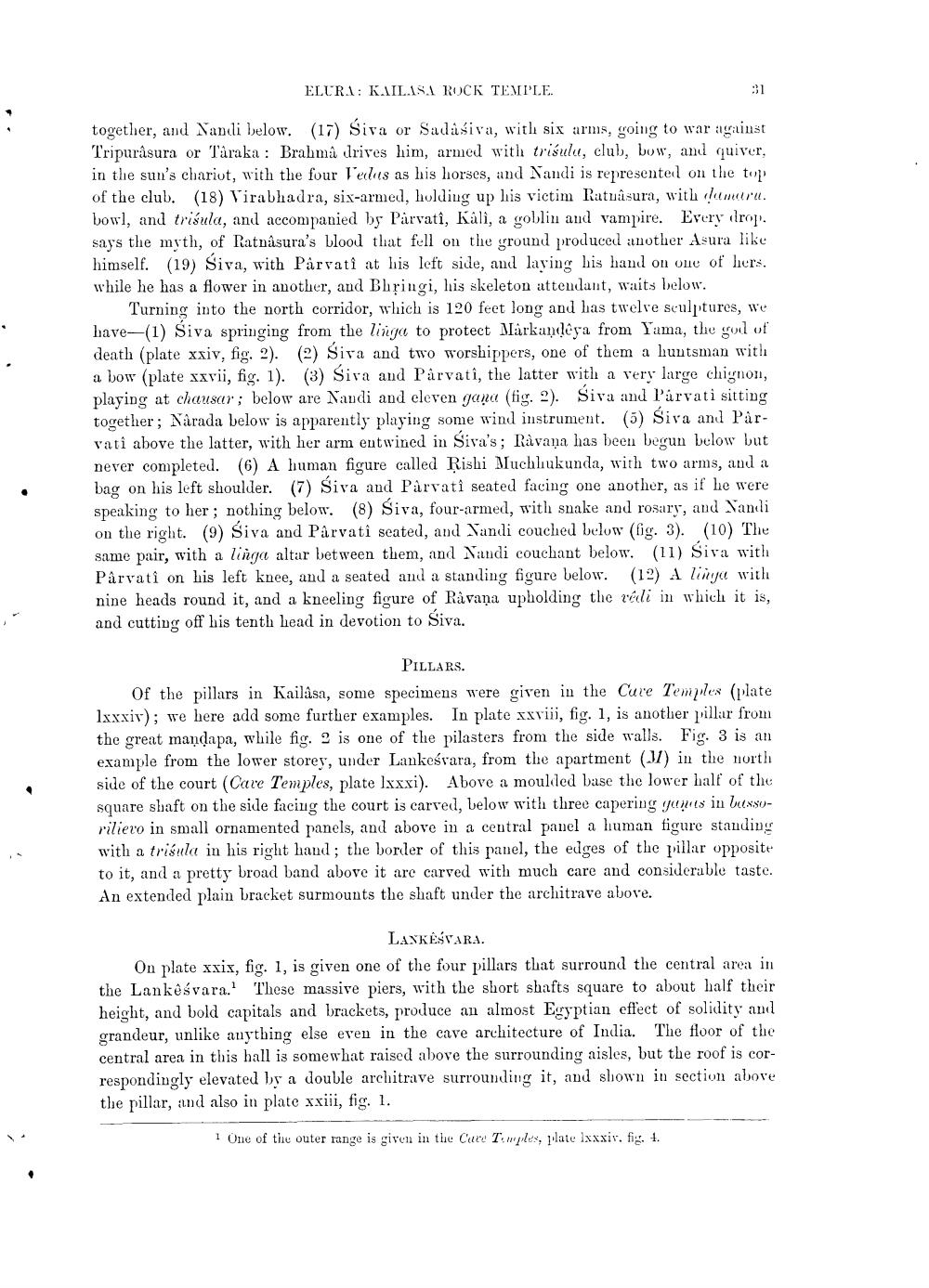________________
ELURI: KAILIS ROCK TEMPLE
together, and Nandi below. (17) Siva or Sadasiva, with six arms, going to war against Tripurasura or Taraka : Brahmå drives him, armed with trisulu, club, bow, and quiver, in the sun's chariot, with the four l'eddus as his horses, and Nandi is represented on the top of the club). (18) Virabhadra, six-armed, holding up his victim Ratuầsura, with damru. bowl, and tribula, and accompanied by Parvatî, Kali, a goblin and vampire. Every drop. says the myth, of Ratnasura's blood that fell on the ground produced another Asura like himself. (19) Siva, with Parvatî at his left side, and laying his hand on one of hers. while he has a flower in another, and Bhringi, his skeleton attendant, waits below.
Turning into the north corridor, which is 120 feet long and has twelve sculptures, we have—(1) Siva springing from the linga to protect Markandêya from Yuma, the god of death (plate xxiv, fig. 2). (2) Sira and two worshippers, one of them a huntsman with a bow (plate xxvii, fig. 1). (3) Siva and Parvati, the latter with a very large chignon, playing at chausar; below are Nandi and eleven gana (fig. 2). Siva and Parvati sitting together; Narada below is apparently playing some wind instrument. (5) Siva and Parvatî above the latter, with her arm entwined in Siva's; Råvana has been begun below but never completed. (6) A human figure called Rishi Muchliukunda, with two arms, and a bag on his left shoulder. (7) Siva and Parvati seated facing one another, as if he were speaking to her; nothing below. (8) Siva, four-armed, with snake and rosary, and Sandi on the right. (9) Siva and Parvatî seated, and Nandi couched below (fig. 3). (10) The same pair, with a linga altar between them, and Nandi couchant below. (11) Siva with Pârvatî on his left knee, and a seated and a standing figure below. (12) A linya with nine heads round it, and a kneeling figure of Råvana upholding the vali in which it is, and cutting off his tenth head in devotion to Siva.
PILLARS. Of the pillars in Kailasa, some specimens were given in the Cure Temples (plate lxxxiv); we here add some further examples. In plate xxviii, fig. 1, is another pillar from the great mandapa, while fig. 2 is one of the pilasters from the side walls. Fig. 3 is an example from the lower storey, under Lankesvara, from the apartment (11) in the north side of the court (Care Temples, plate lxxxi). Above a moulded base the lower half of the square shaft on the side facing the court is carved, below with three capering yanus in luxsorilievo in small ornamented panels, and above in a central panel a human figure standing with a trisula in his right hand; the border of this panel, the edges of the pillar opposite to it, and a pretty broad band above it are carved with much care and considerable taste. An extended plain bracket surmounts the shaft under the architrave above.
LANKESVARA. On plate xxix, fig. 1, is given one of the four pillars that surround the central area in the Lankośvara. These massive piers, with the short shafts square to about half their height, and bold capitals and brackets, produce an almost Egyptian effect of solidity and grandeur, unlike anything else eren in the cave architecture of India. The floor of the central area in this hall is somewhat raised above the surrounding aisles, but the roof is correspondingly elevated by a double architrave surrounding it, and shown in section above the pillar, and also in plate xxiii, fig. 1.
1 One of the outer range is given in the Cart Towples, jilate lxxxiv, fig. 1.




